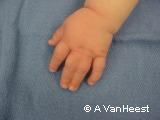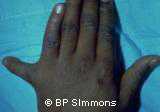 What is it?
What is it?
Some babies are born with hands that are, in various ways, different than normal hands.
What causes it?
Upper limbs are formed between one and two months after embryo formation. At four weeks, an arm bud develops, which sends messages to the other cells during the formation of the upper arm. A normal arm is formed by following millions of these steps. If any of these steps fail, a congenital hand difference may occur. Some may be caused by genes, but some don’t seem to have an apparent cause.
 What are the signs?
What are the signs?
There are several ways congenital hand differences present in babies: missing arm parts, webbed fingers, extra digits, under or overgrowth of hand parts, or constriction band syndrome. Different variations tend to be associated with race. In Caucasians, webbed fingers is most common. In the black population, a sixth digit next to the little finger is often seen, while an extra thumb is most common among Asians.
 How do we diagnose it?
How do we diagnose it?
It’s very important that a hand surgery specialist evaluate your child, given that there is so much variation in types of congenital hand differences. The surgeon can help decide if you should seek treatment. The physician may want to look more into your genetic background or do further medical testing to determine the best course of action.
How is it treated?
Assessment and treatment plans are always made on an individual basis depending on the type. Extra digits, for example, are often removed. Surgery may significantly improve hand function if the difference impedes normal movement. In some cases, therapy is recommended to help patients become accustomed to abnormalities or surgical modifications. In still other cases, no treatment is required at all.


